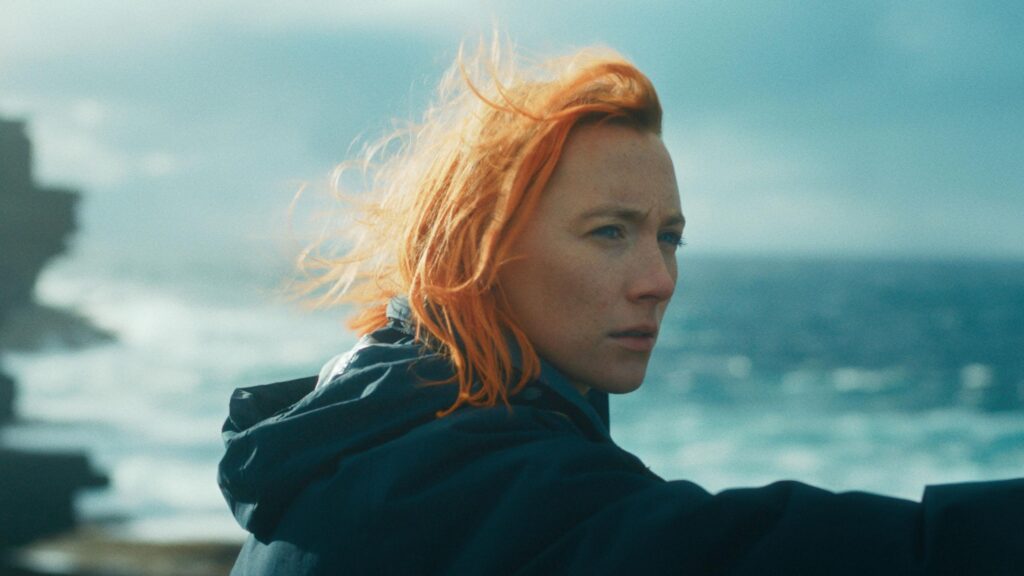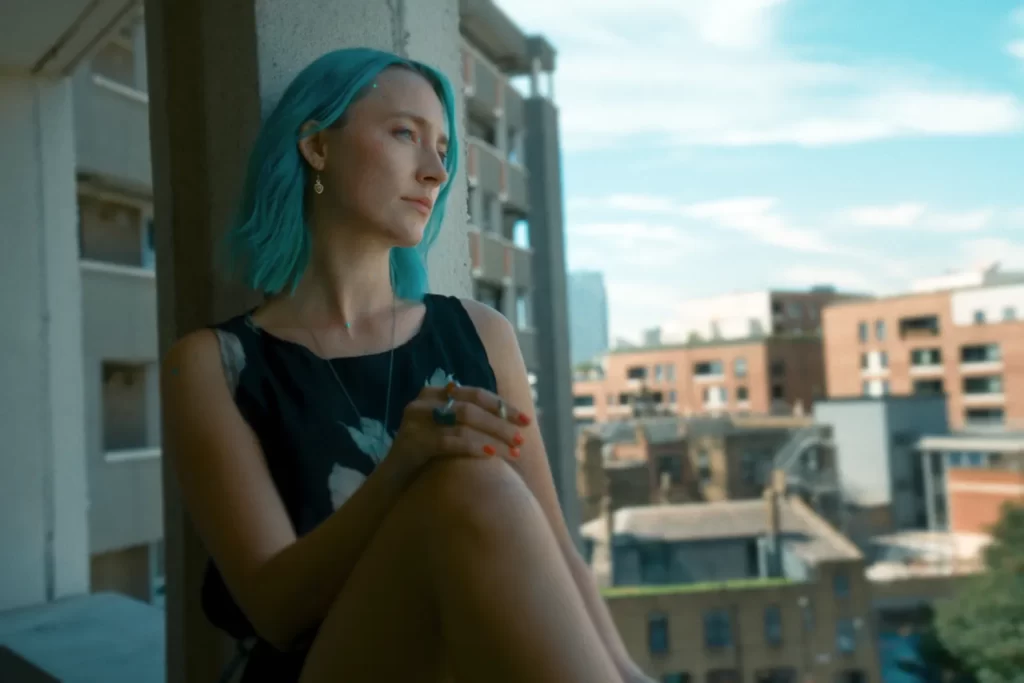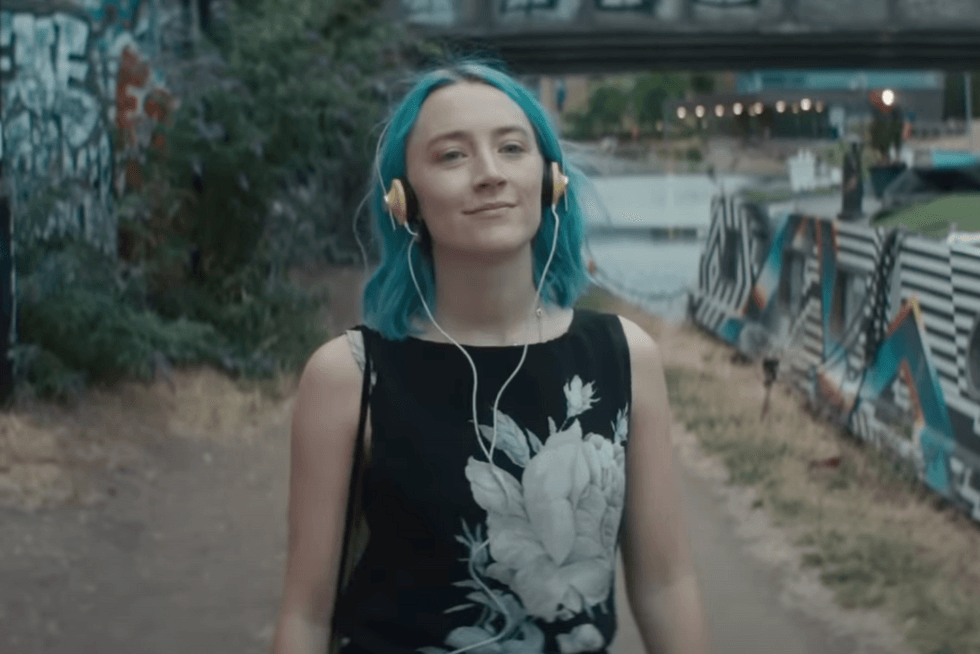
The first time we see Saoirse Ronan’s face in The Outrun, she’s dancing in a nightclub, neck tilted upward and lips slightly parted, like she’s trying to kiss a black sky. It’s an image of divine rapture, which makes it a jarring contrast to her next few appearances—first getting unceremoniously dragged out of a bar after hours, then checking herself into a rehabilitation clinic while sporting a horrific purple bruise over her right eye. For this woman, agony can follow ecstasy in the span of a night or the blink of a single camera cut.
The notion that substance abuse can inspire both pleasure and pain is by no means novel; cinema is littered with depictions of actors articulating the euphoria and despair caused by various intoxicants. And The Outrun, which was directed by Nora Fingscheidt from a screenplay she wrote with Amy Liptrot (based on the latter’s book), doesn’t entirely evade the durable conventions of the genre. But it does inject those old customs with considerable new life, thanks both to the boldness of its structure and the vivacity of its lead performance. You’ve seen this movie before, but also, you very much haven’t.

It is presumably an alphabetic coincidence that Ronan’s surname is only one letter removed from Rona, the character she imbues here such empathy and intelligence, but it nonetheless speaks to the inhabiting quality of her work. There is nothing unprecedented about her acting in The Outrun, even as she credibly conveys the highs and lows of her subject’s passion and predicament. Instead there is an invisible acuity, a sense of emotional comprehension whereby she recognizes Rona’s individuality without upstaging it. She keeps things small except when she needs to go big, and as a result she embodies the role fully, with perfect clarity and without undue embellishment.
Stripped to its studs, The Outrun comprises the raw materials of the addiction drama: the recoveries and the relapses, the feverish parties and the ugly breakups, the howling arguments and the muted 12-step meetings. Anticipating that its broad trajectory is familiar, Fingscheidt and Liptrot have chosen to scramble the story’s chronology, leaping back and forth in time rather than traversing a predetermined arc. This technique isn’t without its hazards—nonlinear plotting has calcified into its own cliché—but here it mostly pays off, minimizing the sense of repetition that inheres in every dependency narrative. Drunks drink until they don’t, and then they do again; by constantly fast-forwarding and then rewinding, the movie disrupts its otherwise predictable patterns. (Viewers’ potential disorientation is blunted by the color of Rona’s hair, which is streaked blue in varying degrees depending on the period.)

For her part, Rona attempts to thwart her own recurrent and self-destructive behavior by literally removing herself from its temptations. Initially a biology student in London—she’s dating a good-looking guy (Paapa Essiedu, from Men), and their relationship seems happy except for the nights she goes on benders and never comes home—she relocates to her childhood home of Orkney, an island chain off Scotland. There she spars with her mother (Slow Horses’ Saskia Reeves), whose religious devotion she finds distasteful, and dotes on her father (Stephen Dillane), whose bipolar disorder etches the film with an additional layer of anguish. Mostly she just tries to distract herself from wanting another drink; some days the distractions work better than others.
The sequences in which The Outrun grapples with Rona’s alcoholism—whether witnessing her in the throes of the disease or chronicling her efforts to overcome it—are its most traditional. But they are still effective, thanks both to Ronan’s razor-sharp instincts (watch the moment when she hesitates before asking her ex-boyfriend to go grab a drink) and to the screenplay’s uncommon frankness. “I miss it,” Rona says of drinking during a group therapy session, where she’s been informed that only 10% of patients are likely to complete their rehab. “I miss how good it made me feel.” Scenes like that lend the movie a powerful honesty, such as when a wizened AA member informs Rona, “It gets easier, but it never gets easy.” They also bring a terrible force to the wrenching sequence in her dad’s trailer: She dabs her finger in a glass of wine, then heads outside and freezes for a few agonizing seconds—her sapphire eyes reflecting the eternal struggle between her better angels and her body chemistry’s desires—before inevitably turning back around. (Fingscheidt occasionally supplies an on-screen counter tabulating Rona’s days of sobriety; its sudden reset to zero constitutes its own gut-punch.)

Still, The Outrun is most hypnotic when it ventures away from its central conflict and simply observes Rona in communion with the natural world, noise-cancelling headphones often clamped onto her ears. The script, which Liptrot based on her own experiences, supplies Rona with a voiceover that is decidedly divergent from your typical narration. Rather than commenting on her own troubles, she informs the audience of various scientific facts—sometimes about alcohol (it’s an intoxicant and a depressant, who knew!), but more often about flora and fauna, including the corncrake, the endangered species of bird whose survival she resolves to help protect. The metaphor may be obvious, and Fingscheidt’s intimate directorial style—she favors extreme close-ups, which take advantage of Ronan’s expressive face but also tend to produce a wavering sensation—may be imprecise. But there is a richness to Rona’s wanderings that remove the picture from the generic territory of the usual addict and deposit it in the land of the personal, where it is imprinted it with the specificity of memoir.
Not a ton of substance happens in The Outrun—just a woman’s life perpetually expanding and contracting, like an accordion of human possibility. Late in the movie, Rona’s voiceover shifts from intellectual to individual, as she describes her body as harboring a geology befitting its own continent. It’s a beautifully written passage (“Lightning strikes every time I sneeze, and when I orgasm, there’s an earthquake”), accompanied by a rush of gorgeous images. It’s followed by a sublime final scene in which Rona, the long-suffering victim and petulant child, is at last allowed to emit a bark of laughter. It’s a quiet moment that carries no real narrative significance. It is also the sound of triumph.
Grade: A-
Jeremy Beck is the editor-in-chief of MovieManifesto. He watches more movies and television than he probably should.
